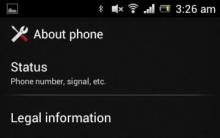Photo noise is a perennial problem faced by beginner photography enthusiasts and professionals alike. Digital noise appears as individual dots of light, dark, or color that can fill entire areas in a photo. Mobile phone owners who shoot in low light with their gadgets are well aware of this problem. However, owners of advanced SLR cameras are often faced with the fact that contrasting points appear in the photographs, which spoil the overall impression of the pictures. In this article we will talk about how to reduce the influence of noise on photos when shooting, as well as how to eliminate such minor image defects with software.
Reducing noise in the photo when shooting
It should be noted right away that there is always noise in digital photography, and this is due to the peculiarities of the photosensitive matrix, which is the basis of any digital camera. However, in most cases, the noise level is so low that the human eye is unable to see image defects. But in some situations, especially when shooting in low light conditions, digital noise in the picture is already clearly visible. There are several ways to reduce the effect of noise when shooting:
- Do not use high sensitivity valuesISO
Perhaps the main reason for the appearance of noise in photographs is too high ISO sensitivity set by the photographer. When shooting in low light in the absence of a flash, you have to increase the sensitivity of the matrix to make the photo brighter. However, increasing the ISO value in the camera settings too much will make the images too noisy.
The influence of the ISO value can be estimated using an example, in the area of the photo inside the red oval (clickable):
Noise reduction
1 of 3


While photographic equipment manufacturers are currently working hard to reduce noise at high ISO settings, you shouldn't recklessly use the wider ISO range. It is better to choose the lowest possible or average ISO value, and only after test photos make the appropriate conclusions about the need to increase the sensitivity of the matrix. Therefore, increase the ISO value only when really necessary.
Try using fast lenses or flash in low light conditions. As for the optics, the wider the aperture is opened, the faster the shutter speed can be. All this will allow you to take better quality photos in low light without the need to seriously increase the ISO sensitivity and, thereby, increase the risk of noise.
- Shoot with a tripod
To reduce noise, it is advisable to use a tripod or monopod on which you can mount your digital camera. This is especially true for situations where you are shooting any kind of static subject in low light conditions. Using a tripod will allow the camera's sensor sensitivity to be set to its lowest setting, which in turn will reduce the likelihood of digital noise appearing in pictures.
- Preventing the camera from overheating
It is no secret that digital noise begins to manifest itself more strongly when the sensor of a digital camera heats up. A simple rule applies here - the higher the temperature of the matrix, the more noise in the photo image. In this regard, try not to shoot for a long time in conditions of heat, high humidity and direct sunlight, and also do not use too long exposures unnecessarily.
In addition, take into account the fact that when using LiveView mode in digital SLR cameras, the light sensor works not only during the exposure of the frame, but also a little longer, which can lead to additional heating. Therefore, do not overuse shooting in this mode, give the sensor of your camera time to cool down.
- Shooting inRAW
Shoot preferably in RAW format. This format contains more information than JPEG, so you have more opportunities to get a high-quality picture. In addition, you will be able to reduce the noise in the photo image already when converting RAW files using the image processing software.
Modern digital cameras are equipped with various noise reduction functions, but the software algorithms used in them are far from perfect and do not always suppress noise correctly. Often, using such a function leads to the loss of fine image details. In addition, if your camera has already removed some of the noise, this can complicate the subsequent processing and fine-tuning of the photo on a computer.
How to remove noise from a photo in Photoshop

Using the capabilities of one of the graphic editors, you can safely remove digital noise from your photo. In Adobe Photoshop, this procedure is usually performed through the standard Reduce Noise filter (through the menu Filter - Noise - Reduce Noise). Before processing the image, you need to open it in Photoshop and duplicate it (Layers - Duplicatelayer). Thanks to this, at the end of the noise removal work, you can always compare the original with the processed image. After opening the Reduce Noise filter, you start working in the (Basic) mode, where the following options will be available:
- Intensity or strength (Strength). This parameter reduces the luminance noise - the more to the right you move the slider, the more the noise will be attenuated. The main thing here is not to overdo it, so that various small details do not disappear from the photo along with the digital noise.
- Preserve Details. By adjusting this slider, you can restore the disappeared small details of the photo, but keep in mind that noise will also return in the photo. Here you have to find the optimal balance between leaving the fine details of the photo and resigning to the presence of a certain level of noise, and in order to completely eliminate the noise, resigning to the loss of some details.
- Reduce color noise (Reduce Color Noise). This option is used to remove color spots from the photo.
- Sharpen Details. With this option, you can try to restore the sharpness of the photo image, which naturally deteriorates with decreasing digital noise.
1 of 2


ISO 25600 - after noise reduction
Experiment with the settings, and then go to the additional mode of the same filter (Advanced). Here you can reduce noise in a single channel thanks to the Per Channel tab. For each channel, you can change all of the above-mentioned parameters "Intensity" and "Save details".
Find the optimal filter settings for your particular photographic image. If you need to get rid of the so-called luminance noise, that is, from small elements in the photo that have differences in brightness, then you can start with the following settings: Intensity - 9 - 10, Preservation of details - 3 - 6%. If you are dealing with chromatic noise (the presence of colored spots in the photo), then you can set the following value of Reduce Color Noise - 70 - 100%.
In conclusion, it should be noted that the degree of the problem of digital noise in photographic images is often exaggerated by the photographers themselves, who simply do not want to see any "defects" in their photographs. However, it should be remembered that when examining a picture at 100% scale on a computer monitor, you will see noise that is several times larger in area than in the same photo posted, for example, in an online photo album. In addition to this, no general-purpose noise removal algorithms currently exist. This means that suppression of noise or its elimination by software means one way or another leads to a partial loss of small details, deterioration of color accuracy and sharpness of the photo. Therefore, you do not need to strive to always completely remove noise in your photographs, in most cases it will be enough to simply reduce it to an acceptable level. Although if you plan to engage in commercial or stock photography, then you will have to be more strict with the technical side of the images and similar minor defects in photographic images.

Content of the article:
Introduction
Not so long ago I needed to remove noise from sound. Previously, I had not done this, so I went to the Internet to dig out a way to do this with the least loss. After 10 minutes of searching, it turned out that all the paths lead to Adobe Audition.
After half an hour of experimentation, I figured out the best way to remove noise. Now I present to you quite detailed instructions on how to do this. I will try to collect all the information found together, summarize and write in an accessible language. I'll make a reservation right away that there will be only instructions, and not a description of a bunch of filters for this monster (Audition). Instructions like "If you have a problem - here's a solution." And Audition is essentially Photoshop in the audio world.
Let's say you recorded sound on a microphone, camera, telephone. Often, these devices do not differ in special quality (in terms of sound recording). And there will always be noise - some kind of constant component. And if there is also a generator of additional noise (for example, the hum of coolers in the computer) ... Our task is to separate it from speech or music.
There are two options here:
- The audio contains a recording of the atmosphere of a room or street without a useful signal. Those. in the presence of a recording of noise without impurities. For example, let's say you’re about to record your friend’s guitar playing using a computer microphone. The apartment is quite quiet, there are no neighbors, no one makes noise on the street either (hmm, a rather idealized situation, isn't it), but a nasty computer, which is a hundred years old at lunchtime, and besides, it has not been cleaned of dust from the day it was born, is treacherous thunders coolers all over Ivanovskaya. Well, there are two options: initially write 10-20 seconds before the friend starts playing and the same after the end. In this case, you will have a pronounced noise, which can later be separated. By the way, professional journalists do this whenever possible. And the second option is to clean your computer. Moreover, the second is clearly preferable.
- There is no separate recording of noise in audio. Those. your friend started playing as soon as the recording started, and after the end, you instantly turned off the microphone. This is the worst case scenario. The point is that noise is a collection of specific frequencies. If there is pure noise, then it's safe to say that these frequencies are noise, junk and can be removed from the entire track. If there is some useful signal in parallel with the noise, then the selected frequencies will no longer be exclusively garbage. And when you delete them on the whole track, some part of the useful signal will be lost. Or rather, the music and voice will take on a metallic hue. Therefore, it is better to overwrite such a recording. You can also try to find an area where there will be a minimum of the useful signal, put less aggressive settings when cleaning the noise, and put up with a metallic response. Or you can simply record a noise sample in a separate file, unless of course you are 1000 km away from this place.
There is a small original file of 5 seconds with a pronounced background noise. The recording was done on a smartphone dictaphone. And this noise is generated precisely by the phone and is clearly audible at a low volume of the signal source.
A microphone is a device that senses sound waves and converts them into electromagnetic vibrations. Due to its high sensitivity, the microphone can pick up unwanted signals that generate strong interference. Noise and interference in the microphone occurs for a number of reasons that can be a serious problem when recording sound or transmitting voice messages over the Internet. In order to remove interference in the microphone, you must first find out why this happened.
Background noise in the microphone
Microphones are used on stage, in household sound recording and when communicating over the Internet. Each situation may have its own reasons for extraneous noise in the microphone. The following reasons for the appearance of extraneous noise are usually considered:
- Defective or poor quality microphone
- Disturbances in the connecting cable
- External interference
- Incorrect setting
- Bad software
To get rid of the noise in the microphone, you first need to test the device itself. A defective microphone is rarely a source of noise. Usually in this case, severe distortion occurs in the transmission of the audio signal. Sometimes a bad microphone can be a source of extraneous sound. If the receiver of sound vibrations is connected via a cable and a connector, then to check it, it is enough to change the sound channel. In this case, the persistence of noise or distortion indicates a malfunction of the microphone. For high-quality sound recording, you should not use cheap devices. They are unreliable and often fail.
How to suppress background noise from a microphone
If noise comes from the microphone, this may be due to a break in the ground or common wire. In this case, the low-frequency background will be clearly audible in the speakers. To eliminate this cause, you need to carefully check the cable and restore the broken connection. Suppression of microphone noise can be associated with the elimination of poor-quality contact at any point in the amplifying path.

Microphones can be remote or built into any technical device. The removed devices, in addition to violations in the connecting cable, may have external causes causing extraneous noise. One of these reasons can be an overestimation of the preamplifier channel, when acoustic feedback occurs between the devices. In this case, a pulsating tone will be heard in the speakers, which may change when the position of the audio device is changed. To remove buzzing and unnecessary noise in the microphone, you can reduce the level in the audio equipment. To get rid of the noise of the microphone during recording, in some cases, you can simply select a different installation point for the device. It happens that a sound device perceives external noises or sound from operating technical equipment. Then you can eliminate the noise in the microphone by putting on a protective screen on the working part of the device. It is usually made from foam rubber and is most commonly used in outdoor recording applications.
How to completely remove noise from a microphone
Devices for receiving sound vibrations built into household appliances may have other causes of noise. If there are extraneous sounds, you need to know how to get rid of the background noise in the microphone. Many people who use programs to communicate over the Internet often face such problems. Sounds interfere with good sound recording and normal communication. It is possible to remove electrical noise in a microphone, but to do this, you need to know the cause of its occurrence. The causes of microphone noise can be influenced by the following:
- Incorrect program settings
- Outdated drivers
- External interference from electronics
In order to check the microphone of a computer or tablet, you need to perform actions depending on the type and version of the operating system. In older Windows operating systems, right-click on the speaker icon in the lower left corner of the screen and select the "Recorders" line in the list that appears.

Next, on the microphone icon, right-click to open the context menu and select "Properties". Open the "Listen" item and control the operation of the microphone through the speakers of the speaker system. If there is no distortion, extraneous noise is not perceived, but the voice is played too quietly, then by opening the "Levels" item, you can use the slider to adjust the sensitivity level. If the WEB-camera is located far away, then the level can be raised to the required value. This is selected empirically.

If there is strong distortion or extraneous noise, you can check the sampling rate. To do this, open the "Advanced" item and on the tab set "1 channel 16 bit 44100 Hz (CD). If, after all the actions, strong noises in the microphone do not disappear, then you will probably have to replace it. What to do if noise in the microphone interferes with communication through popular services. To check the correct operation of the sound channel in Skype, you need to do the following:
- Enter the program
- Select the section "Tools"
- Open the line "Settings" and "Sound settings"
Mark the line "Microphone settings automatically" and in the "Test" mode make sure the sound quality is normal. If the device is humming and the noise on the background of the microphone does not disappear, you should reduce the sensitivity level of the device. The Mail.ru Agent program also has a "Program settings" item. In the "Voice and video" tab, select the "Automatic sound settings" item. If the sensitivity of the device is weak, you can put a tick in front of the item "Microphone gain". The modes can be adjusted manually, but auto-tuning eliminates the need to rebuild the device with changing recording and playback factors.
If a Linux operating system is installed on a computer or tablet, the methods for removing noise in the microphone will be slightly different. The reason may lie in a low-quality device. In this case, after checking the sound channel, when other reasons are eliminated, it can be replaced. But first you need to use the PulseAudio audio server, which will greatly improve the quality of your audio device.
The audioserver has a noise reduction module that works according to the webrtc or speex algorithm. To do this, run the required program as follows: PULSE_PROP = ”filter.want = echo-cancel” skype. After that, all communication via Skype will take place without echo and extraneous noise.
The next way is to create constant source and sink with noise suppression across the spectrum: load-module-echo-cancel source name = noechosource sinc name = noe chosinc set-default-source noechosource
You can write these lines anywhere in /etc/pulse/default.pa so that they are automatically executed every time PulseAudio is started.
When using this noise reduction option, you should be aware that the module works both for recording and for reproduction, therefore, when working with voice communication programs, everything will be fine, and problems may arise when recording high-quality sound. When using noise reduction using the second method, you need to make sure that the program plays sound with noise reduction, and not directly into the audio card. When playing music from the computer's built-in player via the noise canceling sinc, the audio files will be played in mono and at a sampling rate of 32 kHz, which is very poor quality.
How to remove noise in a microphone from a computer
This defect most often occurs in laptops, where the small size of the device does not allow far enough to separate the device, which is sensitive to sound waves, and some kind of electric drives. Most often, noise in the microphone can appear from the operation of the electric motor of the hard disk drive or the ventilation cooler. But it so happens that some modes of the computer also cause the appearance of noise in the microphone. If Windows is set to power saving mode, it may cause noise. In order to make sure of this, you need to enter the "Power supply" settings item and switch it from the saving mode to the "High performance" mode. After restarting your computer, the interference may disappear.
Another cause of noise interference can be the connection of incorrect devices to the computer. They are usually connected via a USB port and receive power from there. If the external device is poorly assembled, then the power supply interference will get into the headphones. This is not directly related to the microphone, although some motorized external devices may generate vibration that will travel to headphones or speakers through the microphone channel. You can make sure that there is an external source of noise by sequentially disconnecting all external devices from the ports.
Strong microphone noise
Audio playback may be interfering if the computer is not properly connected to the network. The microphone channel is very sensitive to various network interference. Any household appliances can create them. In addition, 50 Hz low frequency interference can enter the microphone channel if the device is not grounded. Ideally, the computer should be connected to a grounded European power outlet. It is also impossible to include a computer and other household appliances in one extension cord. A separate extension cord with a mandatory surge protector must be provided for it.
Generally, the word “noise” is most often used to describe a sound that is often loud and causes irritation or other negative reactions. But sometimes noise does not mean only sound distortion, which interferes with the transmission of a signal or information.
In photography, noise refers to graininess and false color in an image, often resulting in loss of detail and color distortion.
Noise is the same electronic interference that you see on a TV screen, hear on the radio or during a telephone conversation. In cameras, such noise appears to be something like sand grains, which, as the interference increases, themselves increase in size, color variations and become more and more disordered. In most cases, good cameras are able to mitigate noise quite satisfactorily, and cameras with full-frame sensors do the job best.
The noise in photographs increases as the ISO value increases or as the shutter speed is slower, as the so-called signal-to-noise ratio increases. Trying to get more photo information, we amplify the signal, but this inevitably leads to errors in transmission (accordingly, to the appearance of noise).
This image vividly illustrates the appearance of specks and grains of erroneous colors, this kind of noise is common when using high values.ISO, i.e. when we try to make the image lighter and brighter. ISO 3200 on the EOS 1D Mark IV.
A camera's ability to reduce noise encompasses several different aspects: sensor size, technology, digital processor, software, and the photographer's own input (camera settings, etc.). In order to initially create photos with a minimum amount of noise, you need to become familiar with all the factors that affect their appearance.
Reducing noise
The noise reduction function, roughly speaking, cleans up the signal received by the camera. Noise reduction algorithms try to eliminate various types of noise, which are expressed in the form of noise in photographs.

Even after a slight reduction in noise, there is a noticeable improvement in the overall appearance of the picture. False colors have been removed, grain is smoother, and detail has been increased.

A shot of the ring, taken using daylight and a low power LED to add sparkle. Camera settings: 1 / 100sec, f / 8.0, ISO 3200, 100mm macro. In a programmeNoise reduction has been applied in Lightroom.
It is impossible to completely get rid of noise, since the signal cannot be perfectly clear. Suppressing noise is not the same as eliminating noise altogether. In addition, excessive use of the noise canceling function may result in loss of picture quality. Therefore, without fanaticism, always select the most optimal values that do not affect the quality of the photo.

Excessive noise reduction loses both detail and image sharpness.
As with the camera, noise reduction during post-processing is essentially a balancing act between the original capabilities of the camera, the capabilities of the software being used, and custom settings.
Noise reduction feature in Lightroom
In the Develop module in Adobe Photoshop Lightroom, you will find a section called Detail, where the Sharpening and Noise Reduction tools we need are located. The Noise Reduction tool is divided into two subsections: Luminance and Color. Each of the categories has its own set of adjustment sliders.
The Luminance slider controls the graininess, and the Color slider controls the noise color. Accordingly, the first slider will soften graininess, while the second will work with elements whose color is out of the general picture. Since the program delineates the areas of noise reduction, you can understand what type of noise is dominating in your photo.
Luminance Noise Reduction
The first section of the Noise Reduction tool contains sliders related to Luminance: Luminance, Detail and Contrast. They control three aspects of luminance noise.

The effect is most noticeable when you move the first Luminance slider, the other two sliders make more subtle changes.
- The Luminance slider focuses on the graininess of the noise. As the effect increases, the grains will coalesce more and more. If you move the slider too far, details such as hair and fabric texture will simply disappear.
- The next Detail slider adjusts the threshold of the effect that the change in Luminance creates. That is, it helps to restore some of the details that were lost after using the slider responsible for the brightness of the noise (Luminance).
- Finally, the Contrast slider affects the contrast of each individual grain. It works similarly to the standard contrast tool, but on a smaller scale. Its effect is subtle, even at 100.
Noise Reduction Color

The effect is most noticeable when you move the first sliderColor, the other two sliders make more subtle changes.
- The Color slider affects the “color ripple” in your photo, making pixels color uniform. But if you drag the slider too far, all similar colors will blend and smooth out.
- The Detail slider works similarly to the slider of the same name in the Luminance section and adjusts the threshold of the effect created.
- The Smoothness slider controls how smooth the transition between the corrected colors will be. It is similar to the Contrast slider. Its effect is also subtle.
Other noise reduction tools
Sometimes there is a need to apply the noise suppression function selectively, i.e. not all areas of the image. Three tools in LightRoom allow you to do this: Radial Filter, Gradient Filter and Adjustment Brush. Each of these tools has a slider with which you can adjust the noise only in those areas to which the tool was applied.

Selectively applying noise reduction is especially useful in situations where a global change will result in loss of image quality, or when you want more control over the application of the noise reduction effect. For example, when the brightness is increased, the shadows tend to make more noise than the bright areas. You can use one of these tools to reduce noise in the shadow areas of your photo.
Sharpening and noise reduction
An outdated camera, very high ISO settings, and other factors can result in intense noise that needs to be suppressed. However, in many cases, strong noise cancellation leads to an unpleasant consequence, namely, loss of detail and blurring. To counteract this effect, you can apply the Sharpening tool.
Even with a seemingly insignificant shift of the Sharpening slider, there are quite significant changes. However, using this tool can again bring back the noise that we so persistently got rid of. There is a little trick for this case, namely the Masking slider, which helps restore sharpness without affecting our noise reduction work. When set to 0, the effect is applied to the entire photo. As the value is increased, the effect is spread over a smaller area, namely the edges with high contrast.

Holding down the keyAlt as you move the slider, you can observe the areas of application of this effect. White areas are an area of application. This feature is useful in cases where the main goal is to reduce noise, but you want to keep the edges sharp.

We have illustrated the difference between photographs with different metrics.Masking. For the first photo, the value was set to 80%, and for the second 20%.
The big advantage of using the Sharpening mask in conjunction with the Noise Reduction tool is that it allows you to set high Noise Reduction values while keeping the edges sharp. This unit is suitable for processing leather, walls, sky and other flat surfaces.
Presets for noise reduction
The ultimate goal of this lesson is to create presets in Lightroom, taking into account the cameras and ISO values used, for further reusable use. In general, presets are a guarantee of significant time savings. Let me give you an example from personal experience. The noise that appears in photos taken with my Canon EOS 1D Mark IV becomes quite noticeable at ISO 3200 and above, so I created presets for specific parameters.
Depending on the parameters set on your camera and its characteristics, you can also apply additional manipulations to the presets, such as Hue-Saturation (Hue / Saturation), Luminance (Brightness), etc.

I created an outlined preset for editing photographs that I shoot in a specific location where I most often use.ISO 3200. Over time, I added custom white balance settings to this preset. Now, in one click, I can edit (get rid of noise and correct the white balance) all the photos taken under these conditions.
Conclusion
And although the work on the noise begins immediately during shooting (low ISO values, correct exposure), it is nevertheless important to be able to get rid of noise during post-processing. Your camera will do its best, and Lightroom will improve the result. Applying the correct noise reduction techniques will allow you to publish and print your photos in a larger format. Using presets will significantly save you time spent on post-processing.
Photos with noise are a kind of defect resulting from poor lighting. A large number of washed out color spots are distributed throughout the image, greatly reducing its quality. This article describes how to remove noise in Photoshop. There are several options for solving the problem.
Instructions
The best way to deal with grainy noise is to prevent it from occurring. Poor quality shots are obtained in low light conditions when the photographer has to increase the ISO values a lot.
Already at an indicator equal to 400, extraneous elements appear on the images. If the ISO is increased to 800, then the noise cannot be avoided. The quality of the photo is greatly reduced due to blurred spots. You can remove defects using the tools built into the image editor.
How to remove noise in Photoshop using a filter
What if the photo is not in RAW format? How to remove noise in a photo in Photoshop if they were not removed at the stage of converting the file? To do this, open the picture in an image editor. Then you need to open the "Filter" section in the main menu. Next, go to the "Noise" tab.
The first filter to be tested is located here. It is required to select the "Reduce noise" line. Next, you should proceed with the settings. The Strength and Preserve Details sliders are responsible for removing or reducing luminance noise. If you increase the first indicator to the maximum value, you will notice that the defects in the photo will be eliminated, but the text in the picture will become blurry.

The problem is that the fight against luminance noise causes a decrease in the sharpness and detail of the image. Attentive users will notice that a second slider has been added to the program so that the photo does not lose quality. After increasing the indicator, sharpness and detail appear, and with them noise. If there are no small elements in the image, then you can leave the second slider untouched.
Other settings
How to remove color noise in Photoshop? To do this, move the Reduce color noise slider. At the same time, the sharpness of the text will not decrease, the noise will disappear, but small details will lose their saturation. Users will notice that a colored halo has formed around the red spots. In rare cases, such changes may not be acceptable for the snapshot. For this reason, the minimum squelch values should be set. If the shooting was set to ISO 6400, then removing all defects in the image using the filter will fail. Therefore, it is necessary to avoid the high sensitivity of the matrix.
How to remove noise in Photoshop using the Adobe Camera RAW filter
First you need to download and install the plugin. Then you need to run the "Photoshop" program and go to the menu. After that, you need to mark the line "Open" in the "File" section. In order for the photo upload window to appear, you can press the CTRL + O keys. Next, you need to select a picture with noises. To the right of the File Name line, type Camera Raw. The snapshot will immediately open in the program filter.

Then you need to go to the settings. After that, you need to open the "Filter" section in the menu. Next, you need to mark the line Camera Raw. The filter window will appear. It can also be opened using the SHIFT + CTRL + A keys.
Plugin setup
How to remove noise in Photoshop using this filter? First, the user needs to configure the plugin. Check the box next to the "Checkout" item. When working with a filter, the user can immediately see the changes in the image. Next, go to the "Detailing" tab. It's the third icon from the left. You can change the scale of the photo using the slider in the bottom corner. It is necessary to increase the indicator to 300%. This is necessary so that the user can see the changes made.
Removing defects
How to remove noise from photos in Photoshop using a plugin? To do this, find the "Color" slider and move it to the right. You should not try to remove brightness noise at this stage. It is enough to remove the color dots. After completing the task, you can begin to reduce the luminance noise. To do this, you need to find the "Luminosity" slider and move it to the right. It is necessary to simultaneously observe the photograph. In each case, the value is determined individually. It is important to keep in mind one rule: the luminance index should always be greater than the chromaticity value.

As a result, the sharpness of the photo will decrease. To make the image clearer, you need to move the "Effect" slider to the right. You can also increase the value for Brightness Information. To save the result, click on the "Ok" button.
conclusions
When working with bitmap images, it is not recommended to use the built-in filter of the Photoshop program. The main reason is the appearance of color halos around bright image elements. It is very difficult to remove luminance noise from smooth surfaces without losing the sharpness of small details. The Camera Raw plug-in allows you to increase ISO up to 6400 even for commercial shooting. The user can remove luminance and color noise while retaining fine details.











The value of avatars in psychology
The value of avatars in psychology
How to stress a letter in MS Word
What does it mean if a person's avatar
How to Create Your Own Twitter Moment